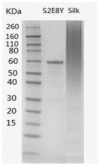Aqueous-Based Coaxial Electrospinning of Genetically Engineered Silk Elastin Core-Shell Nanofibers
- PMID: 28773344
- PMCID: PMC5502692
- DOI: 10.3390/ma9040221
Aqueous-Based Coaxial Electrospinning of Genetically Engineered Silk Elastin Core-Shell Nanofibers
Abstract
A nanofabrication method for the production of flexible core-shell structured silk elastin nanofibers is presented, based on an all-aqueous coaxial electrospinning process. In this process, silk fibroin (SF) and silk-elastin-like protein polymer (SELP), both in aqueous solution, with high and low viscosity, respectively, were used as the inner (core) and outer (shell) layers of the nanofibers. The electrospinnable SF core solution served as a spinning aid for the nonelectrospinnable SELP shell solution. Uniform nanofibers with average diameter from 301 ± 108 nm to 408 ± 150 nm were obtained through adjusting the processing parameters. The core-shell structures of the nanofibers were confirmed by fluorescence and electron microscopy. In order to modulate the mechanical properties and provide stability in water, the as-spun SF-SELP nanofiber mats were treated with methanol vapor to induce β-sheet physical crosslinks. FTIR confirmed the conversion of the secondary structure from a random coil to β-sheets after the methanol treatment. Tensile tests of SF-SELP core-shell structured nanofibers showed good flexibility with elongation at break of 5.20% ± 0.57%, compared with SF nanofibers with an elongation at break of 1.38% ± 0.22%. The SF-SELP core-shell structured nanofibers should provide useful options to explore in the field of biomaterials due to the improved flexibility of the fibrous mats and the presence of a dynamic SELP layer on the outer surface.
Keywords: coaxial electrospinning; core-shell structure; silk fibroin; silk-elastin-like protein polymer.
Conflict of interest statement
The authors have no other relevant affiliations or financial involvement with any organization or entity with a financial interest in or financial conflict with the subject matter or materials discussed in the manuscript. This includes employment, consultancies, honoraria, stock ownership or options, expert testimony, grants or patents received or pending or royalties.
Figures









Similar articles
-
Coaxial electrospinning of composite mats comprised of core/shell poly(methyl methacrylate)/silk fibroin fibers for tissue engineering applications.J Mech Behav Biomed Mater. 2022 Apr;128:105105. doi: 10.1016/j.jmbbm.2022.105105. Epub 2022 Jan 31. J Mech Behav Biomed Mater. 2022. PMID: 35121425
-
Silk fibroin H-fibroin/poly(ε-caprolactone) core-shell nanofibers with enhanced mechanical property and long-term drug release.J Colloid Interface Sci. 2021 Jul;593:142-151. doi: 10.1016/j.jcis.2021.02.099. Epub 2021 Mar 9. J Colloid Interface Sci. 2021. PMID: 33744525
-
Core-shell structured PEO-chitosan nanofibers by coaxial electrospinning.Biomacromolecules. 2012 Feb 13;13(2):412-21. doi: 10.1021/bm201444v. Epub 2012 Jan 25. Biomacromolecules. 2012. PMID: 22229633
-
Core-shell nanofibers as drug delivery systems.Acta Pharm. 2019 Jun 1;69(2):131-153. doi: 10.2478/acph-2019-0014. Acta Pharm. 2019. PMID: 31259723 Review.
-
Silk Fibroin Combined with Electrospinning as a Promising Strategy for Tissue Regeneration.Macromol Biosci. 2023 Feb;23(2):e2200380. doi: 10.1002/mabi.202200380. Epub 2022 Dec 7. Macromol Biosci. 2023. PMID: 36409150 Review.
Cited by
-
Bombyx mori Silk Fibroin Scaffolds with Antheraea pernyi Silk Fibroin Micro/Nano Fibers for Promoting EA. hy926 Cell Proliferation.Materials (Basel). 2017 Oct 3;10(10):1153. doi: 10.3390/ma10101153. Materials (Basel). 2017. PMID: 28972553 Free PMC article.
-
Electrospinning Proteins for Wound Healing Purposes: Opportunities and Challenges.Pharmaceutics. 2020 Dec 22;13(1):4. doi: 10.3390/pharmaceutics13010004. Pharmaceutics. 2020. PMID: 33374930 Free PMC article. Review.
-
Borrowing From Nature: Biopolymers and Biocomposites as Smart Wound Care Materials.Front Bioeng Biotechnol. 2018 Oct 2;6:137. doi: 10.3389/fbioe.2018.00137. eCollection 2018. Front Bioeng Biotechnol. 2018. PMID: 30333972 Free PMC article. Review.
-
A Facile Strategy for Fabrication Lysozyme-Loaded Mesoporous Silica Nanotubes from Electrospun Silk Fibroin Nanofiber Templates.Molecules. 2021 Feb 18;26(4):1073. doi: 10.3390/molecules26041073. Molecules. 2021. PMID: 33670610 Free PMC article.
-
Multifunctional Scaffolds Based on Emulsion and Coaxial Electrospinning Incorporation of Hydroxyapatite for Bone Tissue Regeneration.Int J Mol Sci. 2022 Nov 30;23(23):15016. doi: 10.3390/ijms232315016. Int J Mol Sci. 2022. PMID: 36499342 Free PMC article. Review.
References
-
- Alessandrino A., Marelli B., Arosio C., Fare S., Tanzi M.C., Freddi G. Electrospun silk fibroin mats for tissue engineering. Eng. Life Sci. 2008;8:219–225. doi: 10.1002/elsc.200700067. - DOI
Grants and funding
LinkOut - more resources
Full Text Sources
Other Literature Sources
Miscellaneous

